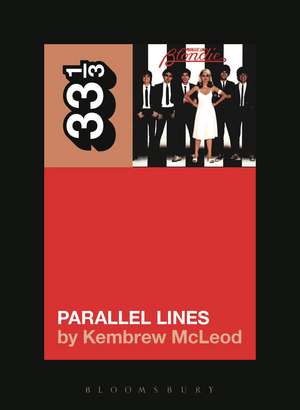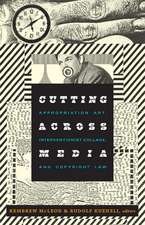Blondie's Parallel Lines: 33 1/3
Autor Kembrew McLeoden Limba Engleză Paperback – 23 mar 2016
Din seria 33 1/3
- 39%
 Preț: 47.02 lei
Preț: 47.02 lei - 39%
 Preț: 46.92 lei
Preț: 46.92 lei - 40%
 Preț: 46.46 lei
Preț: 46.46 lei - 40%
 Preț: 46.65 lei
Preț: 46.65 lei - 39%
 Preț: 46.74 lei
Preț: 46.74 lei - 39%
 Preț: 47.09 lei
Preț: 47.09 lei - 40%
 Preț: 46.29 lei
Preț: 46.29 lei - 39%
 Preț: 46.74 lei
Preț: 46.74 lei - 39%
 Preț: 47.19 lei
Preț: 47.19 lei - 39%
 Preț: 46.74 lei
Preț: 46.74 lei - 39%
 Preț: 47.62 lei
Preț: 47.62 lei - 40%
 Preț: 46.39 lei
Preț: 46.39 lei - 39%
 Preț: 46.92 lei
Preț: 46.92 lei - 39%
 Preț: 46.74 lei
Preț: 46.74 lei - 40%
 Preț: 46.56 lei
Preț: 46.56 lei - 40%
 Preț: 46.46 lei
Preț: 46.46 lei - 39%
 Preț: 46.84 lei
Preț: 46.84 lei - 40%
 Preț: 46.29 lei
Preț: 46.29 lei - 40%
 Preț: 46.56 lei
Preț: 46.56 lei - 40%
 Preț: 46.29 lei
Preț: 46.29 lei - 39%
 Preț: 46.92 lei
Preț: 46.92 lei - 39%
 Preț: 47.53 lei
Preț: 47.53 lei - 39%
 Preț: 46.74 lei
Preț: 46.74 lei - 39%
 Preț: 47.62 lei
Preț: 47.62 lei - 39%
 Preț: 46.92 lei
Preț: 46.92 lei - 39%
 Preț: 47.27 lei
Preț: 47.27 lei - 40%
 Preț: 46.39 lei
Preț: 46.39 lei - 40%
 Preț: 46.29 lei
Preț: 46.29 lei - 39%
 Preț: 46.74 lei
Preț: 46.74 lei - 39%
 Preț: 47.62 lei
Preț: 47.62 lei - 40%
 Preț: 46.02 lei
Preț: 46.02 lei - 39%
 Preț: 47.44 lei
Preț: 47.44 lei - 40%
 Preț: 46.39 lei
Preț: 46.39 lei - 39%
 Preț: 46.92 lei
Preț: 46.92 lei - 39%
 Preț: 47.09 lei
Preț: 47.09 lei - 39%
 Preț: 46.74 lei
Preț: 46.74 lei - 39%
 Preț: 47.19 lei
Preț: 47.19 lei - 39%
 Preț: 46.74 lei
Preț: 46.74 lei - 39%
 Preț: 46.74 lei
Preț: 46.74 lei - 39%
 Preț: 46.74 lei
Preț: 46.74 lei - 39%
 Preț: 46.74 lei
Preț: 46.74 lei - 39%
 Preț: 46.74 lei
Preț: 46.74 lei - 40%
 Preț: 46.65 lei
Preț: 46.65 lei - 39%
 Preț: 47.19 lei
Preț: 47.19 lei - 40%
 Preț: 46.29 lei
Preț: 46.29 lei - 39%
 Preț: 46.74 lei
Preț: 46.74 lei - 40%
 Preț: 46.56 lei
Preț: 46.56 lei - 40%
 Preț: 46.46 lei
Preț: 46.46 lei - 40%
 Preț: 46.56 lei
Preț: 46.56 lei - 39%
 Preț: 46.74 lei
Preț: 46.74 lei
Preț: 46.74 lei
Preț vechi: 77.18 lei
-39% Nou
Puncte Express: 70
Preț estimativ în valută:
8.94€ • 9.36$ • 7.44£
8.94€ • 9.36$ • 7.44£
Carte disponibilă
Livrare economică 10-24 martie
Livrare express 22-28 februarie pentru 46.02 lei
Preluare comenzi: 021 569.72.76
Specificații
ISBN-13: 9781501302374
ISBN-10: 150130237X
Pagini: 168
Dimensiuni: 121 x 165 x 10 mm
Greutate: 0.14 kg
Editura: Bloomsbury Publishing
Colecția Bloomsbury Academic
Seria 33 1/3
Locul publicării:New York, United States
ISBN-10: 150130237X
Pagini: 168
Dimensiuni: 121 x 165 x 10 mm
Greutate: 0.14 kg
Editura: Bloomsbury Publishing
Colecția Bloomsbury Academic
Seria 33 1/3
Locul publicării:New York, United States
Caracteristici
A mesmerizing look into the alternative disco, drag and queer culture that flourished in the downtown club scene of New York City in the 70s
Notă biografică
Kembrew McLeod is a Professor of Communication Studies at the University of Iowa, USA. He has published and produced several books and documentaries about music and popular culture.
Cuprins
Introduction: "Went Walking One Day on the Lower East Side . "Chapter One: Downtown New York in the 1960s and 1970sBlondie's New York GenesPunk's Bubblegum RootsThe Avant-Garde Goes Pop!Children of The Velvet UndergroundMax's Kansas CityChapter Two: Blondie's Arty Antecedents Off-Off-Broadway Sets the Stage for PunkEric Emerson Makes the SceneTwo Stars Align in the Glitter AgePunk's Trash AestheticChapter Three: Parallel ScenesThe Downtown Disco Underground EmergesBlondie Stumbles Into ExistenceCBGB and the Bowery NeighborhoodThe Downtown Rock Scene CoalescesChapter Four: From the Bowery to BlondiemaniaDebbie and Chris RebuildBlondie Takes Off"Going Professional" Art and CommerceChapter Five: "Disco Sucks," "Chicks Can't Rock," Blah Blah Blah"Heart of Glass" Breaks Blondie In AmericaFrom CBGB to Studio 54"Death To Disco!"Punk vs. Disco?Gender TroubleConclusion, or, Fade Away (and Radiate)Postscript: Blondie Points To the Future, Then Ceases To Exist
Recenzii
It's a rare treat when an author busts out a tightly researched agenda that totally flips your perspective on a record, a band, a scene, a genre, and an entire artistic era. Kembrew McLeod provides such a treat with this gloriously revisionist history, positing that Blondie and the core of the New York punk scene's early bands and aesthetics were a product of a wildly vital gay underground theater scene that flourished from the late 1960s to the early 1970s.
A neat snapshot of a time of revolution, reinvention and experimentation ... [This book is] every bit as appetising as the album itself, and an astute, erudite examination of one of the greatest albums of all time.
An interesting thesis well made in this enjoyable addition to the 33 1/3 series.
There's a little book I've been devouring on the subway this past week or two: Blondie's Parallel Lines by Kembrew McLeod. It has had me tracing and re-tracing connections all over the place, re-examining my own assumptions about my own evolving musical tastes and cultural assumptions from the time of my first transistor radio ... Refreshing.
Nothing beats a great argument that makes you think of the album in question in a whole new light, then - of course - sends you right back to the music to love it all over again ... Parallel Lines - the book - is worth reading if you're a devotee of Blondie or the 33 1/3 series (and of course for fans of both already) but if, somehow, you've never experienced this record in your lifetime and haven't yet read any of the other entries into this set of snapshots of classic albums, McLeod's book might instantly, easily, make you a fan of both.
The publisher Bloomsbury cannot be praised highly enough for the 33 1/3 series ... This volume houses countless surprising details ... [and] McLeod writes so informatively and with such inspiration that one cannot dismiss Parallel Lines or any of the other similar music covered in the book.
[Blondie's] Parallel Lines ... gives a good critical insight into how record labels have worked up until the present day ... the whole thing reads very well.
A neat snapshot of a time of revolution, reinvention and experimentation ... [This book is] every bit as appetising as the album itself, and an astute, erudite examination of one of the greatest albums of all time.
An interesting thesis well made in this enjoyable addition to the 33 1/3 series.
There's a little book I've been devouring on the subway this past week or two: Blondie's Parallel Lines by Kembrew McLeod. It has had me tracing and re-tracing connections all over the place, re-examining my own assumptions about my own evolving musical tastes and cultural assumptions from the time of my first transistor radio ... Refreshing.
Nothing beats a great argument that makes you think of the album in question in a whole new light, then - of course - sends you right back to the music to love it all over again ... Parallel Lines - the book - is worth reading if you're a devotee of Blondie or the 33 1/3 series (and of course for fans of both already) but if, somehow, you've never experienced this record in your lifetime and haven't yet read any of the other entries into this set of snapshots of classic albums, McLeod's book might instantly, easily, make you a fan of both.
The publisher Bloomsbury cannot be praised highly enough for the 33 1/3 series ... This volume houses countless surprising details ... [and] McLeod writes so informatively and with such inspiration that one cannot dismiss Parallel Lines or any of the other similar music covered in the book.
[Blondie's] Parallel Lines ... gives a good critical insight into how record labels have worked up until the present day ... the whole thing reads very well.


















